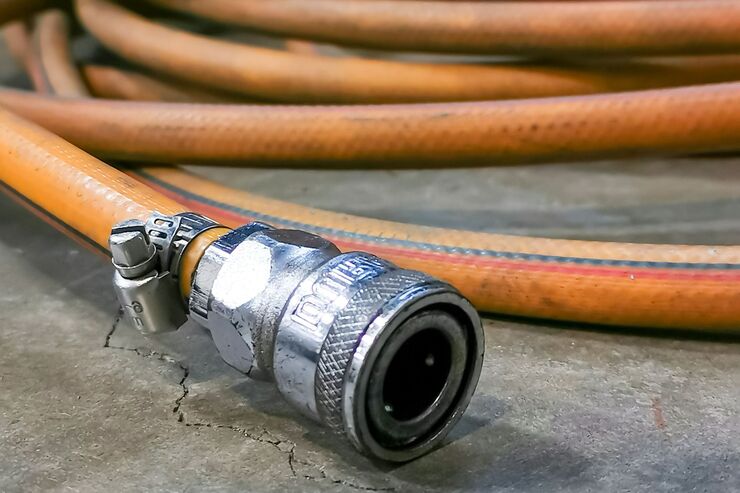Five Energy-Saving Tips for Compressed Air Systems
Compressed air is vitally important to all power plants. Although in some cases it is used simply for convenience, such as when operating certain pneumatic tools, in other cases, compressed air is critical to the operation of the plant, such as for air-operated control valves and some fabric filter cleaning systems. In such cases, a loss of compressed air can result in the forced shutdown of a plant.
Often, the expense associated with compressed air is just considered a cost of doing business. When you really analyze the numbers, though, it is not an insignificant amount. According to the U.S. Department of Energy (DOE), over $5 billion per year is spent on energy in compressed air systems. The DOE estimates that optimizing these systems can improve energy efficiency 20% to 50%. In most plants, it is very likely that a few simple steps could lead to substantial savings.
1. Fix Leaks
It should go without saying that the most obvious place to start is by fixing air leaks. Some experts estimate that as much as 30% of compressed air usage is actually leaking from the system.
Though it is unlikely that a plant with a dedicated maintenance staff would have such waste in the plant’s system, even half of that amount should be considered unacceptable. If you can hear a leak (Figure 1), it is definitely costing you money, but even the leaks you can’t hear should be fixed.

Technology has become so inexpensive these days that it is easy to justify the purchase of an ultrasonic leak detector to find and fix air leaks. An entry-level unit can be purchased for well under $1,000, and it can be used for so much more than just air leaks—such as for detecting steam leaks, compressed gas cylinder leaks, and arcing switchgear components. Soap bubble testing also works for finding air leaks, but it is much more time-consuming.
2. Reduce Pressure
Evaluate system requirements and reduce pressure wherever possible. Conservative DOE estimates indicate that a 2 psig decrease in system pressure will save 1.6% in operating costs.
If a tool or component is designed to operate at a lower pressure than the compressed air system’s normal operating pressure, the equipment will waste air. Reducing the outlet pressure of installed regulators to meet the design specification—or installing and properly adjusting regulators where none exist—will increase efficiency.
There can also be maintenance cost savings realized by lowering air pressure, which can result in less stress on diaphragms and seals. Having less pressure in the system also reduces flow from unnoticed air leaks or leaks that cannot be immediately repaired.
3. Use Alternatives for Air
Although compressed air is readily available and convenient to use in most plants, it is often more cost-effective to find an alternate solution to some problems. Some studies have shown that the overall efficiency of a typical compressed air system can be as low as 10% to 15%. With that in mind, using a fan or even modifying an air conditioning system to cool a component is likely to be less expensive in the long run than installing a compressed air vortex cooler, for example.
Vacuum systems are more efficient and safer for cleaning than compressed air. Electric tools are less expensive to operate than their pneumatic counterparts, although torque and industrial durability need to be considered when selecting the right tool for the job. Ultimately, a person needs to consider all options and use compressed air only when it truly makes sense.
4. Utilize Cooler Intake Air
Denser air requires less energy to compress. Though most compressors are located inside a plant building, many times the suction could easily be ducted to draw air from outside the building. Outside air will generally be cooler and, in some cases, much cooler than ambient air near the compressor. According to some estimates, lowering the intake air temperature from 90F to 70F will lower operating costs by almost 3.8%.
5. Optimize Moisture Drains
Draining moisture from air systems is necessary to ensure proper air quality for system loads. Although it is unlikely that any power plant is using manual drain valves to remove water from the system, if you are, consider upgrading to a drain trap.
Timer-based systems open at regularly scheduled intervals to drain moisture. However, moisture accumulation will vary throughout the year due to seasonal humidity changes. Although the timing sequence can be adjusted to compensate for seasonal changes, the timers frequently are simply set for the worst case scenario—most humid time of year—and left alone. This results in unnecessary air being wasted each time the drain valve cycles. The best option is a no-loss drain trap, which uses a valve and float mechanism. As the water level rises, the float opens the drain valve to remove it. As the level drops, the float closes the valve.
Cut Waste
Although some of these items are “fix it and forget it” solutions, most require regular checkups to ensure problems are caught quickly. Consider scheduling an air system survey quarterly or semi-annually. Remember to check hoses and fittings kept in your tool storage area too. Even though they are probably not continuously pressurized, when used, they are more likely to leak due to the service conditions that they are regularly exposed to.
The biggest benefit to correcting compressed air system deficiencies may be that it sends a positive message to plant staff. Making energy efficiency a priority and developing a company culture focused on waste reduction can lead to big gains throughout the organization.
—Aaron Larson, associate editor (@AaronL_Power, @POWERmagazine)
[Ed. note: This article was originally published in the January 2014 issue of COAL POWER Direct. Updates are made to the article on a regular basis.]